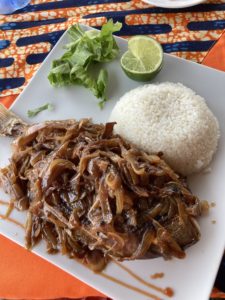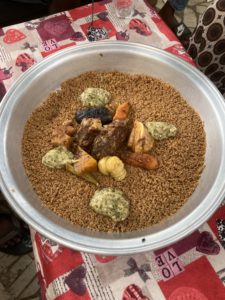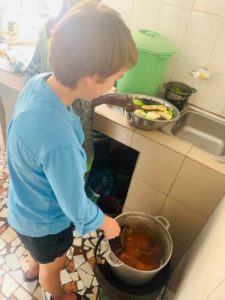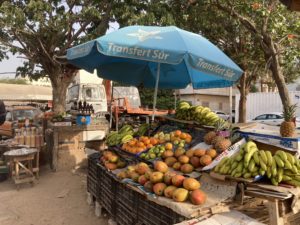Feeling Hungry? A Glimpse: Senegalese Cuisine
July 19, 2021
by Danielle Freshwaters
My classes and activities are starting to wrap up, and though I’ve had a wonderful time in Dakar, I am starting to count the days until I head home (eight). There are some aspects of Senegalese culture that I won’t miss – the traffic congestion and car exhaust, the lack of sidewalks, the bugs – but mostly there are a lot of things that I will miss – the music and dance, the habit of greeting people and always asking about their day, and most definitely the food.

There’s a fish hiding under those onions
Food and drink will be today’s subjects, because I haven’t yet talked in depth about Senegalese cuisine, and who doesn’t love a mouthwatering blog post? In general, my diet has not been that different from what I eat at home, with the exception of more meat and fewer raw vegetables. Luckily I’m not a vegetarian, so the meat is no problem – in fact it’s probably been a good thing for my iron levels. I do love my carrot sticks though, so I’ve made sure to keep a stock in the fridge for snacking.
The flavor base for most Senegalese dishes comes from onions, garlic, onions, peppers (hot peppers, that is), and onions. Yes, lots of onions. In fact, after consuming so many onions over the last several weeks, I decided to investigate their health benefits. Turns out, there are many! Onions contain cancer-fighting compounds, have antibacterial properties, are nutrient dense and high in antioxidants, reduce heart disease risk factors, help control blood sugar, boost bone density, and improve digestive health. A+ for onions.
In addition, many dishes are stewed. Remember how I talked about time being very ambiguous here in Senegal? One might say that the same concept applies in the kitchen. Meats, vegetables, and sauces cook for a loooooooooong time. If you’re hungry, it can be hard to wait, but the result is always worth it. A long cook time brings out the flavors of a dish, and creates tender and juicy meats.

Thieboudienne de Danielle

In the kitchen
One meal in particular that takes a long time to prepare – about three hours start to finish – is thiéboudienne, the national dish of Senegal. It’s a rice-based dish with fish and vegetables, and various sauce accompaniments. This weekend, I got to be the sous-chef, and learn how to prepare it! There are a lot of different parts to prepare, but it’s not too complicated, so I’m looking forward to making it for my family and friends in the US.
I can’t talk about food in Senegal without talking about fruit. Oh, fruit, fresh fruit! We buy mangoes at home, but a mango that’s been imported and refrigerated to stay fresh is nothing compared to a mango that was picked that day from a tree right here in Dakar. Absolutely delicious. In addition to mangoes, I’ve gotten to try lots of new fruits – madd and corossol are two of my favorites. I also love the jus locaux, especially bissap and bouye, which is the fruit of the baobab tree. Unfortunately, fresh produce is one of the things that you can’t bring through customs, so I’ll have to eat and drink my fill before I leave. More mango anyone?

Fruit stands on every street
About the Author
Hello! My name is Danielle, I'm from Tacoma, WA, and I am very excited to be the student blogger (and only student) for APA in Dakar this summer. I enjoy reading, brain games and board games, cooking, and spending time outside. I'm also a runner, so I am looking forward to exploring Dakar on foot!





